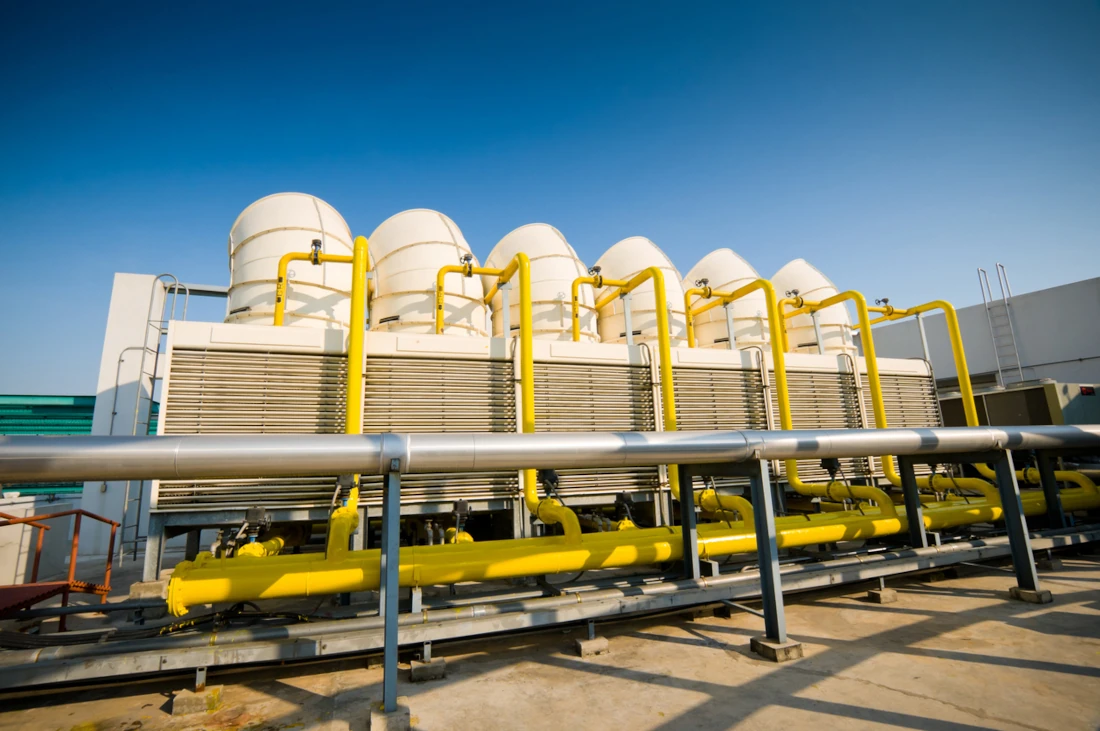
Navigating the Types of HVAC Valves: An Overview
In the HVAC (Heating, Ventilation, and Air Conditioning) industry, valves play a crucial role in fluid and gas flow regulation and management, ensuring the maintenance of appropriate pressure levels.
The HVAC sector encompasses a wide range of equipment, including central air conditioners, boilers, heat pumps, rooftop units, furnaces, packaged units, and chillers, all of which rely on the controlled movement of water, steam, and coolant gases. This control is achieved through the strategic use of various valves.
Valves in HVAC systems are important in regulating the flow of fluids and gases in such equipment, facilitating the seamless operation of these complex systems. By managing flow and pressure, these valves contribute to the efficiency and reliability of HVAC units, ensuring they perform optimally across different settings and conditions.
Here, we explore the valves central to HVAC systems, emphasizing their unique roles, functionalities, and the advantages of using custom valves tailored to enhance system performance.
8 Types of Valves Used in HVAC Systems
Below, we discuss the eight main types of valves used in HVAC systems, including:
- Ball Valves
- Butterfly Valves
- Check Valves
- Pressure Relief Valves
- Balancing Valves
- Float Valves
- Double Block & Bleed Valves
- Control Valves
1. Ball Valves
A ball valve is a mechanical device designed to control the flow of fluids within an HVAC system. It features a spherical disc, the ball, which fits snugly within the valve's body to regulate fluid passage. The ball has a hole, or port, through its center, and when this port is aligned with both ends of the valve, flow is permitted. The rotation of the ball by 90 degrees completely obstructs the flow, making the ball valve highly effective for on/off control.
Equipped with various types of actuators, ball valves can be tailored to meet specific operational needs, offering versatility in controlling different fluid types and pressures. Their design is particularly suited for systems requiring a durable valve capable of full shut-off and rapid operation.
2. Butterfly Valves
Butterfly valves are pivotal in managing fluid flow in HVAC systems, operating through a disc that rotates around a central axis. This modulating element, akin to the wings of a butterfly, can be positioned to allow for full, partial, or no flow through the system.
Butterfly valves are equipped with actuators that facilitate precise control over the disc's position, enabling them to cater to a wide range of flow and pressure requirements. Their compact design makes them an ideal choice for space-constrained applications, offering efficient flow control with minimal pressure drop. Butterfly valves are versatile, capable of handling large volumes of fluid, and are suitable for a variety of system conditions, including those involving corrosive fluids or high-pressure environments.
3. Check Valves
Check valves, or non-return valves, are designed to ensure fluid flows in a single direction, preventing backflow that could potentially damage the system. These mechanical devices operate automatically, opening to allow flow and closing if fluid attempts to reverse direction. The design of check valves varies to accommodate different system requirements, including swing, lift, and ball types, each offering specific advantages in terms of flow resistance and sealing capabilities.
Check valves are essential in HVAC systems for protecting sensitive components and maintaining consistent operation, especially in systems where backflow could lead to operational inefficiencies or safety concerns.
4. Pressure Relief Valves
Pressure relief valves are safety devices engineered to protect HVAC systems from excessive pressure. These valves automatically open at a preset pressure level to vent excess fluid, thereby preventing potential damage from overpressure conditions.
The design of pressure relief valves allows for rapid response to changing system pressures, ensuring that HVAC systems operate within safe pressure limits. Available in various sizes and configurations, pressure relief valves are adaptable to a wide range of system requirements, providing a critical safeguard against pressure-related failures.
5. Balancing Valves
Balancing valves are specialized mechanical devices used to adjust the flow of fluids within HVAC systems, ensuring optimal distribution of heating or cooling resources. By precisely controlling flow rates to different parts of the system, balancing valves enhance overall efficiency and performance.
These valves come equipped with mechanisms for fine-tuning flow, allowing for accurate system balancing that can adapt to changing operational demands. Balancing valves play a crucial role in maintaining comfort levels and energy efficiency in buildings, making them indispensable in modern HVAC system design.
6. Float Valves
Float valves regulate fluid levels in tanks and reservoirs within HVAC systems, utilizing a float mechanism to open or close the valve based on fluid height. As the fluid level rises, the float moves accordingly, triggering the valve to close and prevent further inflow. Conversely, when the fluid level drops, the valve opens to allow additional fluid into the tank. This self-regulating mechanism ensures consistent fluid levels, preventing overflow or depletion.
Float valves are essential for maintaining the proper operation of HVAC systems, particularly in applications involving water cooling or heating processes.
7. Double Block and Bleed Valves
Double block and bleed valves are engineered to enhance isolation and safety in HVAC systems. These valves consist of two separate sealing surfaces (blocks) that can isolate a section of the system, with a bleed mechanism between them to vent or drain the isolated section. This configuration ensures that maintenance, repairs, or system modifications can be carried out safely without shutting down the entire system.
Double block and bleed valves are particularly valuable in critical applications where leakage or cross-contamination could have severe consequences, offering a reliable solution for complex HVAC system requirements.
8. Control Valves
Control valves are essential components in HVAC systems, designed to regulate fluid flow and pressure to meet operational demands. These valves adjust the flow rate by altering the valve opening based on signals from the system's control unit. With a design that can resemble either ball or butterfly valves, control valves are equipped with various types of actuators—pneumatic, electric, or hydraulic—to precisely control their operation. This allows for the fine-tuning of heating, cooling, and ventilation processes, ensuring optimal system performance and energy efficiency.
Control valves are versatile and capable of handling different fluid types and system pressures, making them fundamental for maintaining the desired environmental conditions within a space.
Custom Valves: Enhancing Your HVAC System's Performance
Incorporating custom valves into an HVAC system allows for a high degree of customization and optimization, addressing specific operational challenges and improving overall system efficiency. Whether upgrading an existing system or designing a new one, considering custom valves can provide significant advantages in terms of performance, safety, and cost-efficiency.
Here’s how custom valves can benefit your HVAC systems:
1. Tailored Design for Specific Applications
Custom valves are engineered to handle unique system demands, such as extreme temperatures, pressures, or flow rates standard valves might not withstand. Custom valves ensure optimal performance and longevity of the HVAC system.
2. Increased Efficiency and Energy Savings
Custom valves can improve operational efficiency by reducing leaks and ensuring precise control over fluid flow and pressure, which minimizes energy consumption and operational costs.
3. Enhanced Safety Features
Custom valves can be equipped with specialized features that enhance system safety. This might include higher-grade materials to resist corrosion or wear, or improved sealing capabilities to prevent leaks even under high-pressure conditions. Such features are crucial in critical environments like hospitals or industrial plants.
4. Compatibility and Integration
Custom valves can be designed to be fully compatible with existing equipment, reducing the need for extensive modifications or retrofitting. This compatibility extends to physical dimensions and functional integration with other system components, facilitating a seamless operation.
5. Maintenance and Serviceability
Designed with maintenance in mind, custom valves can simplify service operations. Features such as easier access points, simplified disassembly processes, and built-in diagnostics help reduce downtime and maintenance costs. This is particularly beneficial in complex systems where regular maintenance is crucial for efficient operation.
6. Long-Term Reliability
Custom valves are often made with higher-quality materials and advanced manufacturing processes to ensure durability and reliability. This results in longer service life and fewer failures.
Sealing the Deal: The Critical Role of Valves in HVAC Efficiency
Valves are indispensable components of HVAC systems, each type serving a specific function, from controlling flow and pressure to ensuring safety and efficiency. A solid grasp of HVAC valves is essential for designing, operating, and maintaining effective and efficient HVAC systems.
Ready to learn more about custom valve solutions? Reach out to one of our experts!

